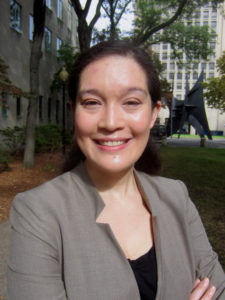by Emma Vander Ende
 If you pause and consider your surroundings, you will find that a type of molecule, called a polymer, surrounds you. Polymers are large molecules that are made up of smaller molecules, called monomers. Monomers link together to form a polymer much in the same way that a necklace is made up of beads (discrete, repeating units).
If you pause and consider your surroundings, you will find that a type of molecule, called a polymer, surrounds you. Polymers are large molecules that are made up of smaller molecules, called monomers. Monomers link together to form a polymer much in the same way that a necklace is made up of beads (discrete, repeating units).
While polymers occur in nature, ranging from natural rubber and silk, to even our DNA, chemists have also synthesized a multitude of synthetic polymers. These include plastics, which pervade our modern world. Polymers are a fascinating class of molecule in part because they offer the potential for a high degree of variety to form functional materials. Chemists can tailor the monomer chemistry to create polymers that have exciting futuristic functions, from conductive molecular wires to “self-healing” polymers that make durable materials.
One such chemist studying polymer chemistry is the most recent hire in the Chemistry Department at Northwestern University: Assistant Professor Julia Kalow. Her research focuses on studying how information about polymer reactivity can be used to tailor the properties of polymers and other soft materials. Research areas that currently interest her include new ways to make conjugated polymers. These polymers contain extended electron networks, and Kalow is interested in how they interact with light inside a magnetic field. She also makes polymers for biomaterials applications – namely, artificial mimics of the extracellular matrix and sophisticated 3D cell culture materials. These materials, she hopes, will help to address complex cell biology problems by advancing biologists’ capabilities to study cells.
Her interest in pursuing an academic career began between her junior and senior years of college at Columbia University, where she started undergraduate research in the Leighton Group after her freshman year. She took a medicinal chemistry internship with Merck Research Laboratories, where her supervisor placed her on a project resembling those in academia. She decided to pursue a PhD in chemistry and the intellectual freedom that academia affords so that she could lead her own projects and follow her own ideas.
As a new assistant professor, she is in the process of establishing her lab and recruiting PhD students to advise and mentor in research. Mentoring students ranks high in Kalow’s list of priorities. She herself earned her PhD (as an NSF GRFP fellow studying asymmetric catalysis) from an assistant professor, Professor Abigail Doyle at Princeton University, and treasures that experience. She and Doyle had a close mentoring relationship, and would frequently talk through her data and results, but Kalow also felt that she had ownership over her research. Towards the end of her PhD, her adviser encouraged her to independently pursue a mechanistic study. “When everything came together on that project, it was very rewarding,” Kalow said of the experience.
Following her PhD, she became a Ruth L. Kirschstein Postdoctoral Fellow at MIT, researching different kinds of polymers with Professor Timothy Swager. She chose the Swager Group in part because of Swager’s success with startup companies. Her experiences researching and collaborating in the challenging intellectual environment of MIT further inspired her to become a professor herself.
Looking to the future, Kalow hopes first to establish her new students in their research and develop reactions and new materials that might change the way that the synthetic polymer community thinks about chemical reactivity. She hopes to form collaborations with other professors at Northwestern, a highly interdisciplinary research institution, to identify particularly useful applications for which her new polymers could fill a need. She is also interested in the possibility of starting a company someday, noting that Northwestern is a great place for innovations and forming startups.
